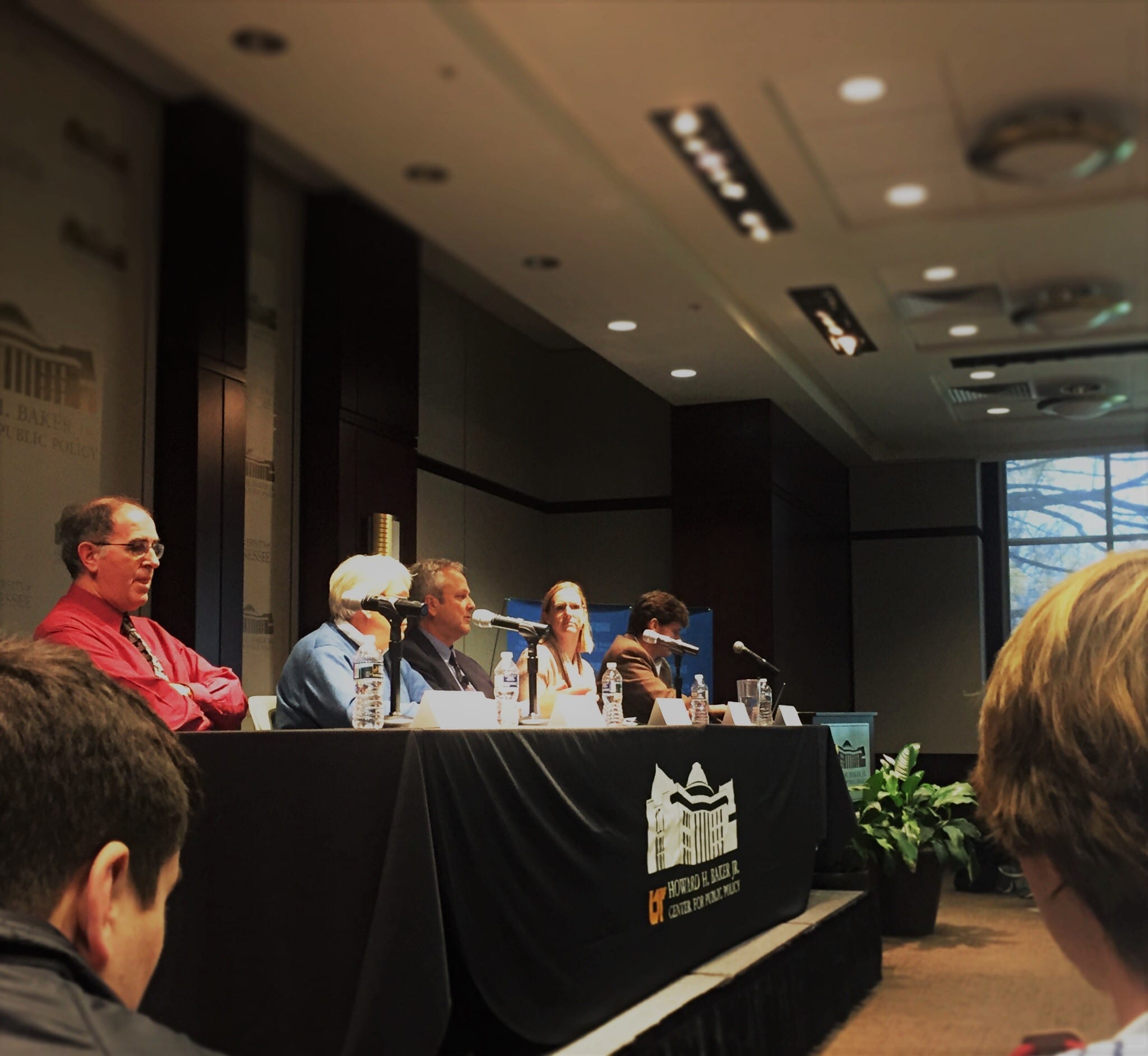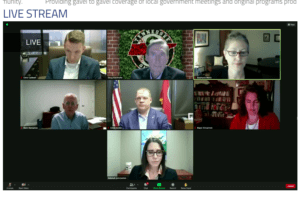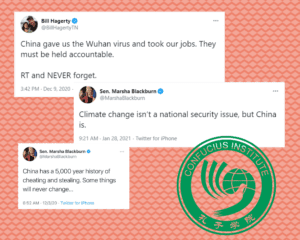Panelists discuss the President-elect’s Potential Policies
The Howard Baker Center hosted a panel this week, where panelists discussed Trump’s potential policies for the next four years.

Credit: Bethany Daniel
On Nov. 30, 2016, the Howard H. Baker Jr Center for Public Policy hosted a panel of individuals to share their outlooks on President-elect Donald Trump’s potential policies for the next four years.
Baker Center director, Matt Murray, opened the panel by explaining the potential economic policies under Trump.
“From a starting point, there are going to be constraints on what President Trump can in fact do in office,” Murray emphasized in the beginning. “Despite the fact there’s a Republican held Senate and House, there will be opposition from some quarters regarding virtually every element of the tax plans that [President Trump] has put forward.”
Murray explained that much of what Trump would be doing would relate to setting tones and regulations of economics, primarily through trade policies and executive order. According to Murray, those areas would face the most influence from the President-elect.
“President Trump has proposed some substantial changes to the taxation of businesses in the U.S.,” Murray said.
According to Murray, Trump’s tax plan entails a reduction in taxes for major corporations from 35 percent to 15 percent which is estimated to cause a revenue loss for the federal government between $5 trillion and $10 trillion within the next decade. In regards to personal income taxes, Trump has proposed collapsing the number of brackets to three, lowering the top personal income tax from 39 percent to 33 percent while raising the lowest tax rate from 10 percent to 12 percent.
Murray said that the distributional consequences of the tax plans for individual households would lead to savings of over a million dollars for those at the top tenth of one percent of our economy and a tax increase for 20 percent of family households, as well as a large majority of single parent households.
“There are significant distributional affects associated with his proposed tax plans,” Murray said.
Murray gave a brief explanation of the president-elect’s tariff proposals. These tariff proposals suggest 45 percent tariffs on imports from China and 35 percent tariffs on imports from Mexico. According to Murray, independent analysts have evaluated Trump’s tariff plans and concluded that they would lead to a global recession.
However, Murray summarized his outlook with an emphasis on the unknown.
“What Trump proposed over the course of the campaign was rhetoric,” said Murray in regards to Trump’s plans. “From here on out, we don’t really know what the reality will be.”
Murray turned the panel over to Dr. Richard Pacelle, the head of the UTK’s Political Science department. Pacelle spoke on the significant matter of judicial appointment.
“The Supreme Court is the most important part of this election,” said Pacelle.
Pacelle explained that over the lifetime of the Supreme Court, about 20 percent of judicial candidates get rejected, but that those rejections typically occur when the president and the Senate are of different parties. This election, however, there is no such imbalance, making the appointment of a Republican justice probable.
“[The Democrats] don’t have the votes to win outright,” said Pacelle. “But they have the votes to keep filibusters going.”
According to Pacelle, the Democrats will be at an advantage with a four-to-four court for as long as the Senate can filibuster the appointment of judicial candidates. This advantage would be owed to the number of democratic lower courts the Obama presidency will have left behind.
Pacelle also praised the ideas of Republican majority leader of the Senate, Mitch McConnell, for his decision to postpone hearings after the death of Justice Scalia. Pacelle attributed reluctant Republican Trump voters eventually coming to the Trump’s side out of a desire to protect the Supreme Court.
Dr. David Greene, a Baker Fellow and retired Oakridge National Laboratory specialist, focused on relating transportation to the environment and climate.
Greene began by citing a quote by the President-elect regarding the removal of the Environmental Protection Agency, leaving only tidbits of it remaining.
“That comment is kind of hard to take seriously,” Greene said. “A car that’s emissions are regulated by the Environmental Protection Agency emits less than 1 percent of the emissions of an unregulated vehicle.”
According to Greene, one of the key issues in question were greenhouse gas emission standards in relation to vehicles and large corporations. In the absence of the EPA, Greene made it clear that only one state has any laws in place to regulate emissions.
“California is the only state in the United States that has the authority under the Clean Air Act to set its own emission standards,” Greene explained. “Other states may adopt California’s standards.”
Greene elaborated further on the matter regarding the potential removal of greenhouse gas regulations under the Trump Administration. With only one state having its own law regulating emissions, and only 15 having become Section 177 states per the federal Clean Air Act of 1970, the removal of a federal law would open doors for massive amounts of greenhouse emissions with little to no restrictions.
Dr. Charles Sims, another Baker Fellow and economist, also spoke on the environmental effects and regulations we can anticipate under a Trump presidency.
Sims primarily observed whether or not it was even possible for the president-elect to do some of the things he said he would do throughout his campaign. Many of the laws, Sims said, would be difficult—if not impossible—to remove. Similarly, laws that Trump might want to put into place would be a difficult goal to achieve, as well. Sims explained another, more efficient approach that the president-elect would likely take.
“He doesn’t have to repeal [rules],” Sims said. “He just has to put people into place that won’t enforce them.”
Sims also spoke about recent federal regulations made regarding methane emissions. According to Sims, these regulations, along with numerous other new regulations being pushed by the Obama Administration, are recent enough to still be under congressional review when Trump takes office.
Dr. Krista Wiegand, a Baker Faculty Fellow and political scientist who specializes in global security, namely acts relating to terrorism.
Wiegand spoke out immediately regarding Trump’s choice of Gov. Nikki Haley of South Carolina as his Ambassador to the United Nations.
“Though Governor Haley doesn’t have any international experience herself,” said Wiegand, “she was chosen mainly because she’s the daughter of immigrants from India. She’s an international face.”
According to Wiegand, the position of U.N. Ambassador was as powerful as it was symbolic, as the ambassador is an international representation of the United States.
Wiegand also spoke about Trump’s desire to build up the United States’ military, improving technology and the overall size. She observed that this seemed to contradict with his desire to withdraw from the wars in Iraq and Afghanistan.
“He doesn’t want to use the military,” said Wiegand. “He just wants to build it up.”
The panel was then opened up for a brief Q&A session involving the audience.
Emma Wiley, a freshman at UT, said, “I don’t think Trump can do as much as we thought he could; but, I also don’t think his choices are the most objective for the country.”
Featured Image by Bethany Daniel
Edited by Kaitlin Flippo



